Kotak Consumption Fund: An opportunity to invest in India's Consumption Growth Story

Kotak Mutual Fund has launched a New Fund Offer, Kotak Consumption Fund. Kotak Consumption Fund will be an actively managed thematic equity scheme. The scheme’s benchmark index is Nifty India Consumption Index. The NFO will open for subscription on 25th October 2023 and will close on 8th November 2023. Domestic consumption is one of the most important drivers of India’s Gross Domestic Product (GDP); India’s consumption expenditure is 60% of India’s GDP (source: ceiecdata.com). Apart from being a driver of economic growth, consumption is also a very attractive and popular investment theme in India. Investors usually relate the Fast-Moving Consumer Goods (FMCG) and the consumer durables sectors to the Consumption theme. However, the consumption theme is much broader and includes a variety of industry sectors that benefit from consumption. In this article, we will review Kotak Consumption Fund NFO.
Private consumption expendituregrowth in India
In the last 10 years, India’s private consumption expenditure grew at a compounded annual growth rate (CAGR) of 5.7% (see the chart below), which is higher than the long term historical average. It is noteworthy that India has been able to maintain a high growth rate of consumption expenditure for the last 10 years despite crossing the $ 1 Trillion GDP mark more than 15 years back.
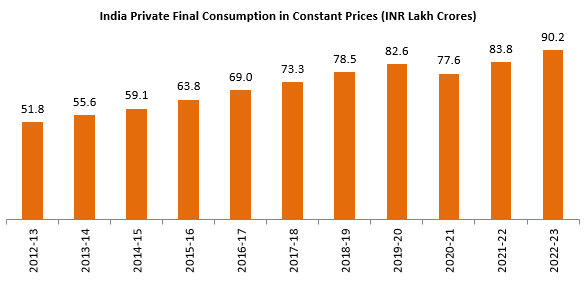
Source: Private Consumption Expenditure at Constant Prices (2011-12 series), Economic Survey (2023), Ministry of Finance, Government of India. Disclaimer: The chart above is for investor educationpurpose only and should not be used for any other purpose.
Drivers of consumption growth rate
- One of the drivers of high PCE growth rate is the demographic dividends of our population. As per National Family Health Survey 2021, 88% of the population is below the age of 60 and more than 65% of the population is in the working age group (see the chart below).
- Rising income on a per capita basis is another driver of PCE growth rate. India’s per capita GDP at constant prices (2015 USD) grew from sub $1,000 levels in the mid 90s to nearly a $2,400 (in 2022-23) (see the chart below). Per capita income of up to $2,000 is mostly spent on basic needs; as it keeps growing above $2,000 discretionary spending rises.
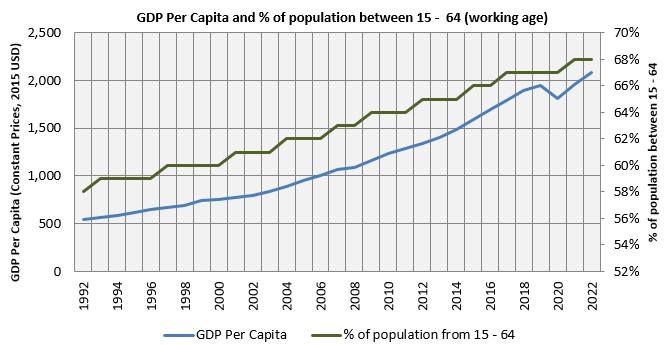
Source: World Bank (1992 – 2022). Disclaimer: The chart above is for investor education purpose only and should not be used for any other purpose.
- Growing urbanization of India is also a major driver of consumption growth. 30 years back 26% of India’s population lived in urban areas. This percentage has now grown to 36%. Since urban incomes are significantly higher than rural incomes, urban spending is also much higher.
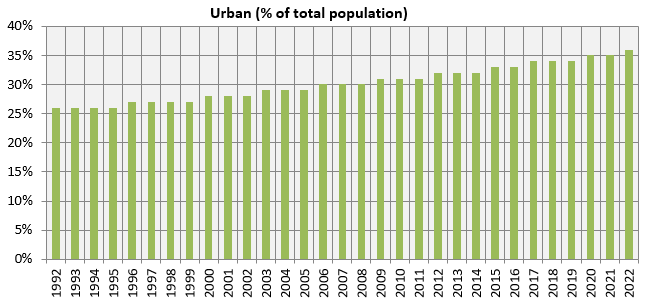
Source: World Bank (1992 – 2022). Disclaimer: The chart above is for investor education purpose only and should not be used for any other purpose.
- Other drivers of consumption growth include shift from unorganized to organized sectors, nuclearization of families, digital penetration and online shopping.
Favourable long term outlook
International Monetary Fund (IMF) forecasted India’s per capita income will rise to $4,000 in the next 5 years (source: IMF). Rise in per capita income along with structural changes in our economy and changing consumer preferences can result in huge growth potential for consumption.
Consumption as an investment theme has outperformed the market
The chart below shows the growth of Rs 10,000 investment in Nifty India Consumption TRI versus the Nifty 50 TRI over the last 10 years. In the last 10 years Nifty India Consumption TRI generated 14.6% CAGR returns, 40 bps higher CAGR returns than Nifty 50 TRI. You can that the consumption index had experienced smaller drawdown compared to Nifty.
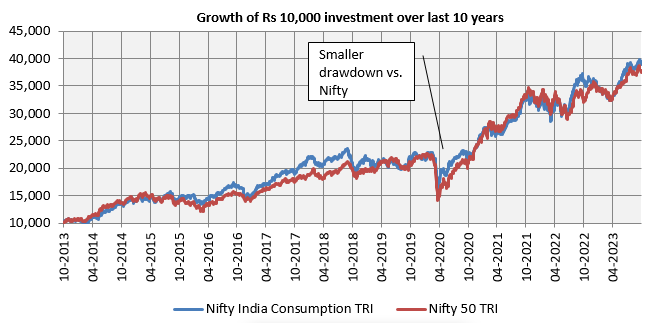
Source: National Stock Exchange, as on 29.09.2023. Disclaimer: Past performance may or may not be sustained in the future
Comparison with different industry sectors
The chart below shows that Nifty India Consumption TRI produced more consistent returns compared to many industry sectors across market cycles. This is because consumption is a secular growth theme which can deliver returns across market cycles.
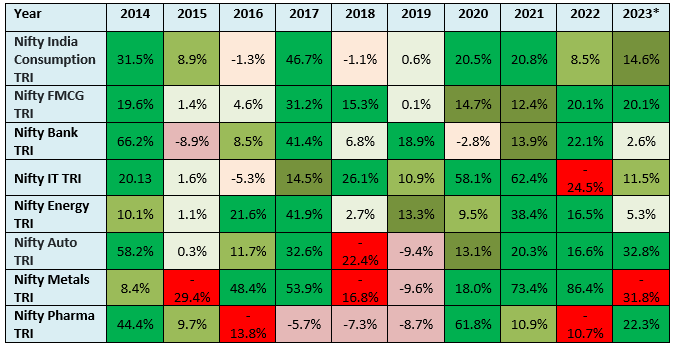
Source: National Stock Exchange, as on 29.09.2023. *September YTD. Disclaimer: Past performance may or may not be sustained in the future. The graphic above is purely for investor education purpose and should not be taken as investment recommendations.
What are the sectors in consumption theme?
Consumption theme is much broader than consumer staples (FMCG) and durables. Itcovers many sectors (see the chart below) that are integral to the India Growth Story.
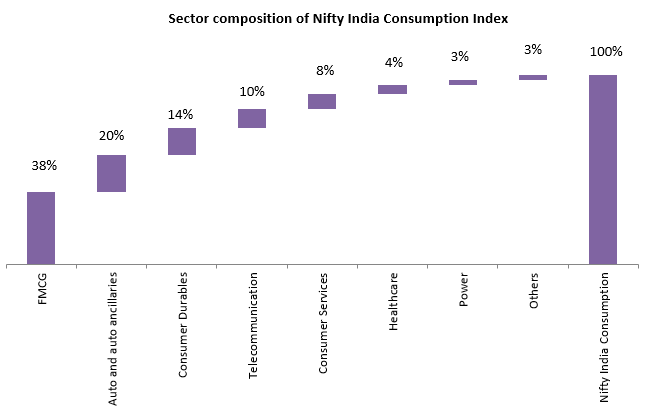
Source: National Stock Exchange, as on 29.09.2023. Disclaimer: The chart above is for investor awareness purposes only and should not be used for any other purpose.
Salient Features of Kotak Consumption Fund
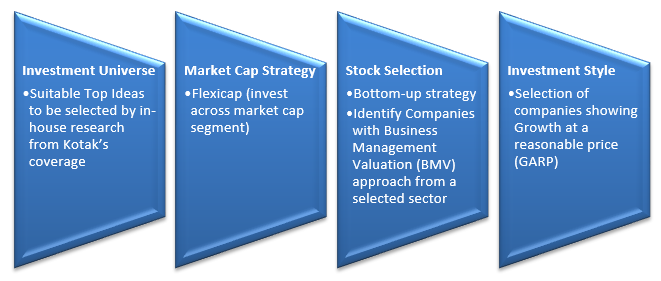
Who should invest in Kotak Consumption Fund?
- Investors looking for capital appreciation over long investment tenures from India’s consumption growth theme
- Investors with high to very high risk appetites
- Investors with minimum 5 year investment tenures
- You can invest either in lump sum and SIP depending on your investment needs.
Investors should consult with their financial advisors or mutual fund distributors if Kotak Consumption Fund is suitable for their investment needs
Mutual Fund Investments are subject to market risk, read all scheme related documents carefully.
Established in 1985 by Mr. Uday Kotak, it was the first Indian non-banking financial company to be given a banking licence by the Reserve Bank of India in February 2003.The group caters to the financial needs of individuals and institutional investors across the globe. Kotak Mutual Fund is the wholly-owned subsidiary of Kotak Mahindra Bank Limited. Kotak Mutual Fund started its operations in December 1998 and is now the 5th largest AMC based on quarterly Average AUM as of December 2020.
Investor Centre
Follow Kotak MF
More About Kotak MF
POST A QUERY










